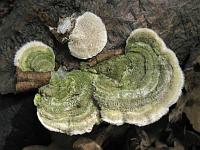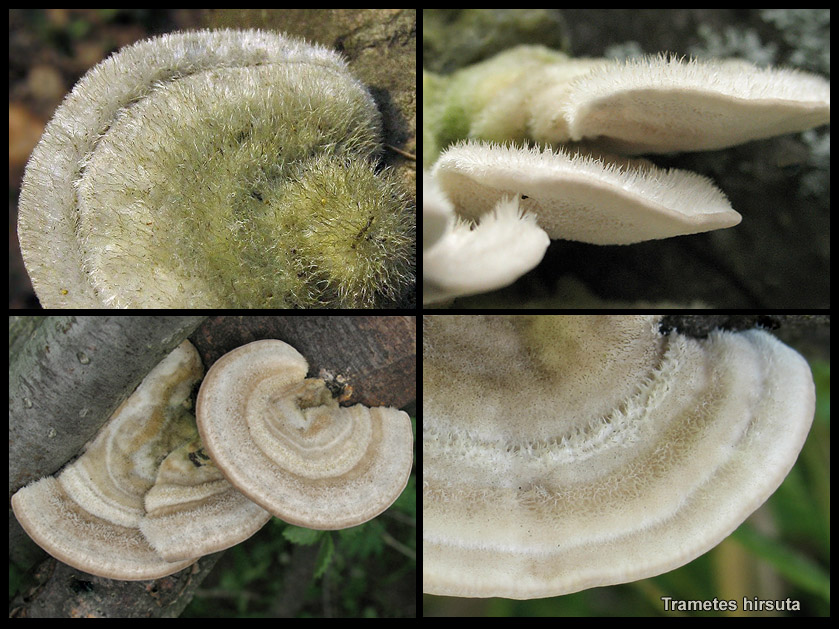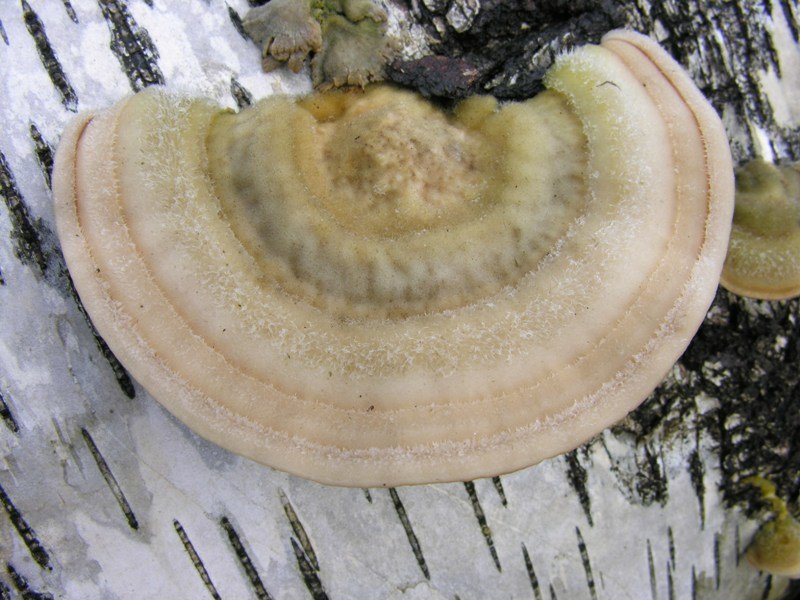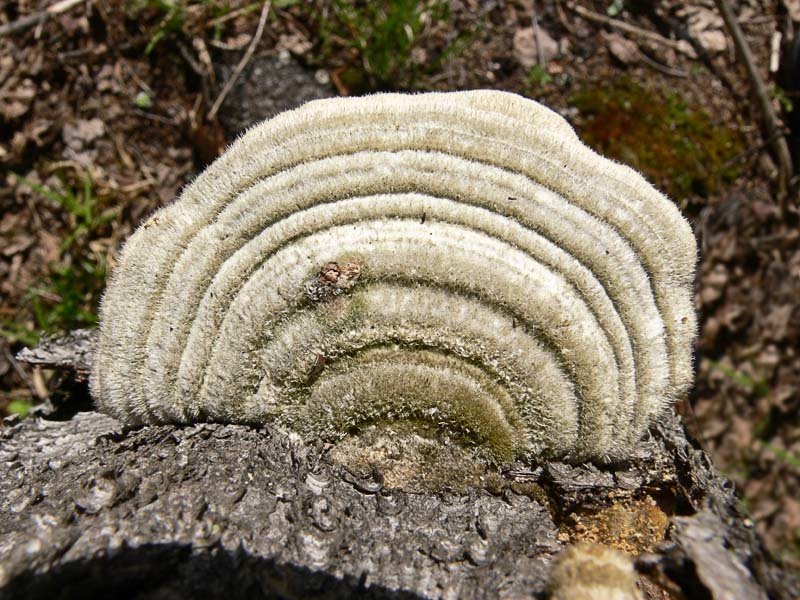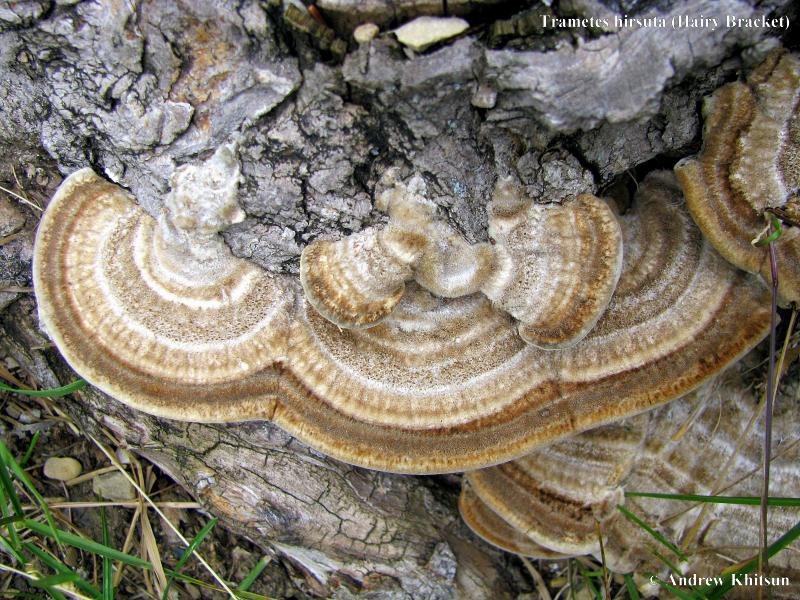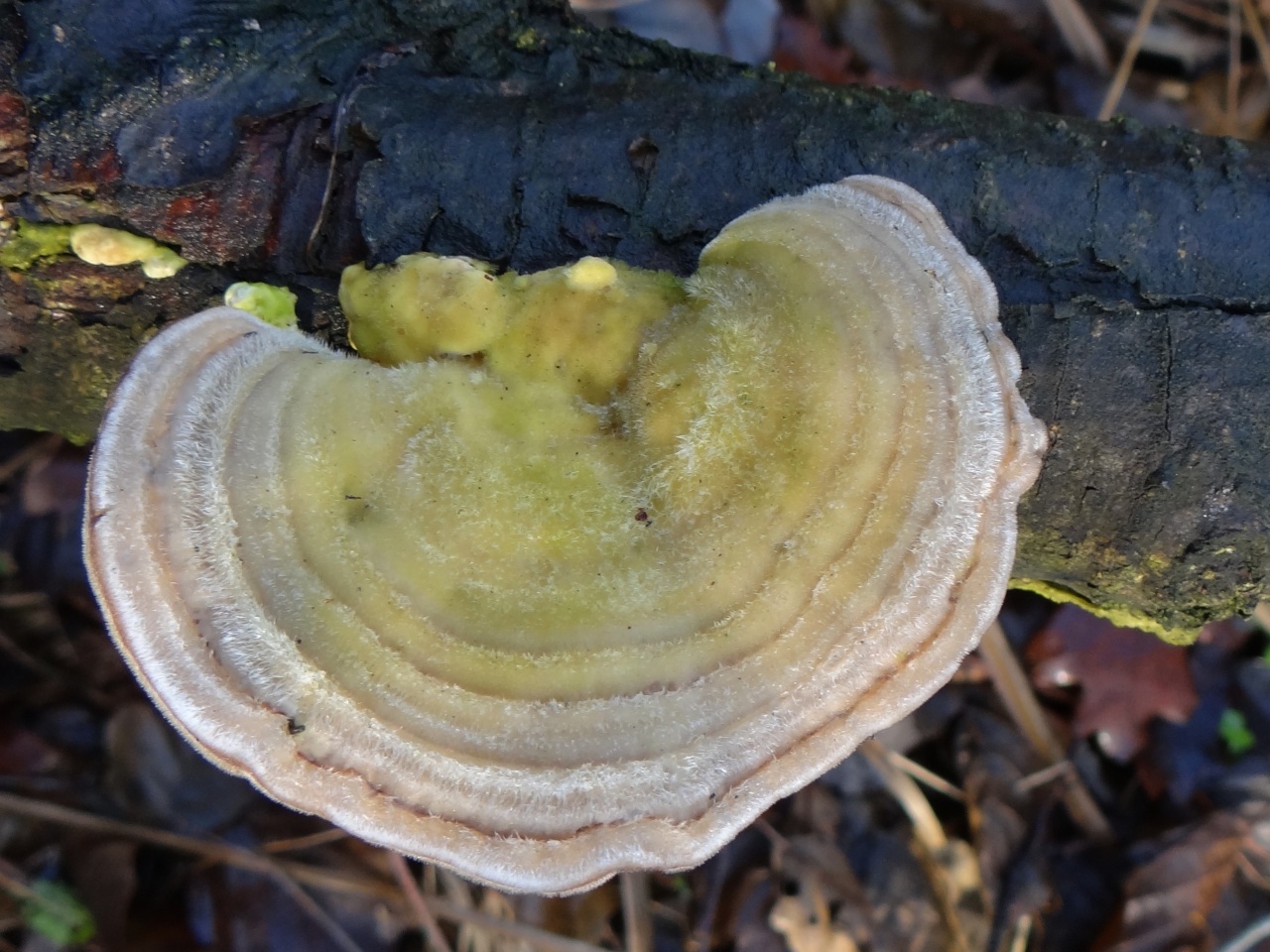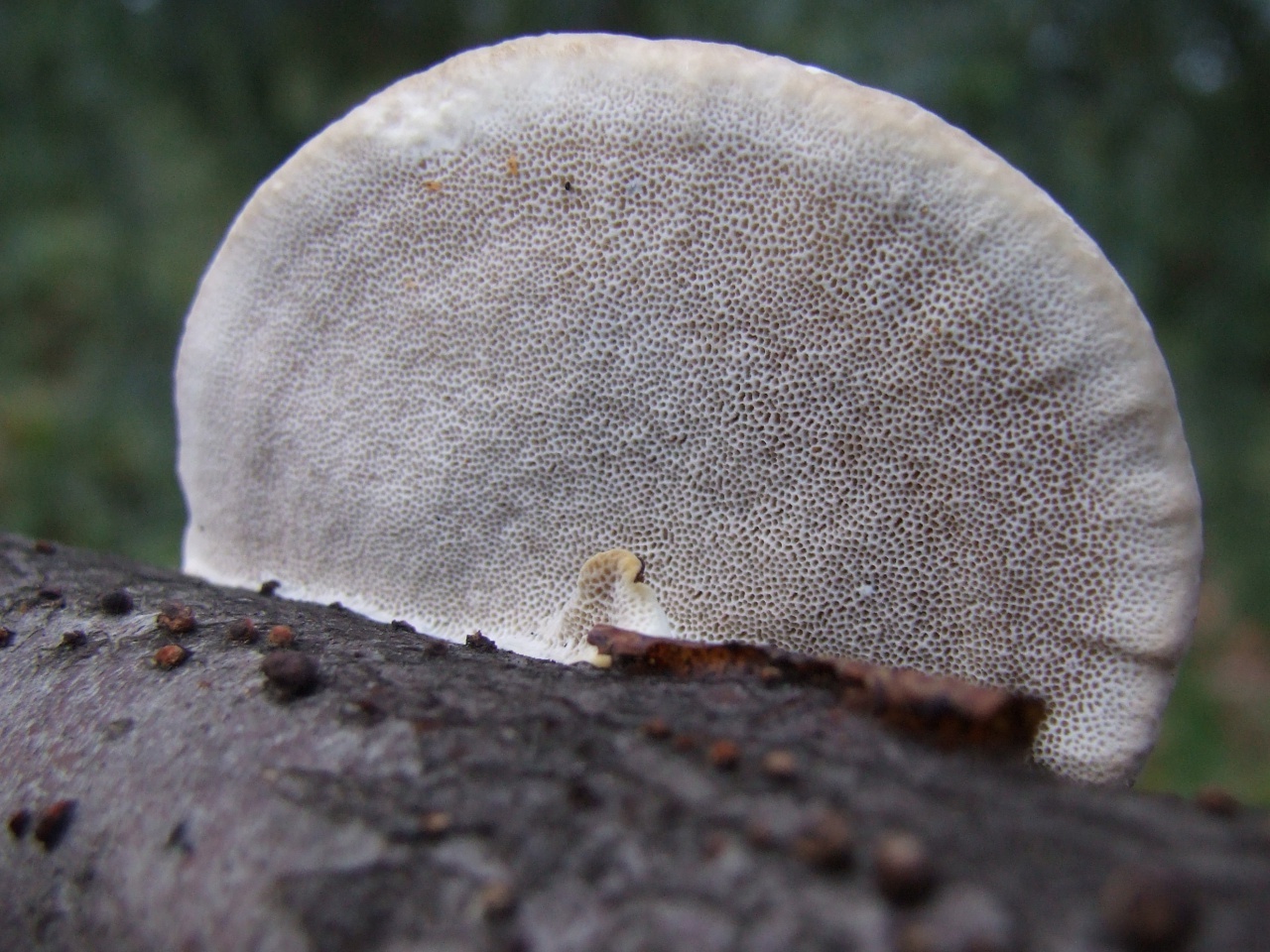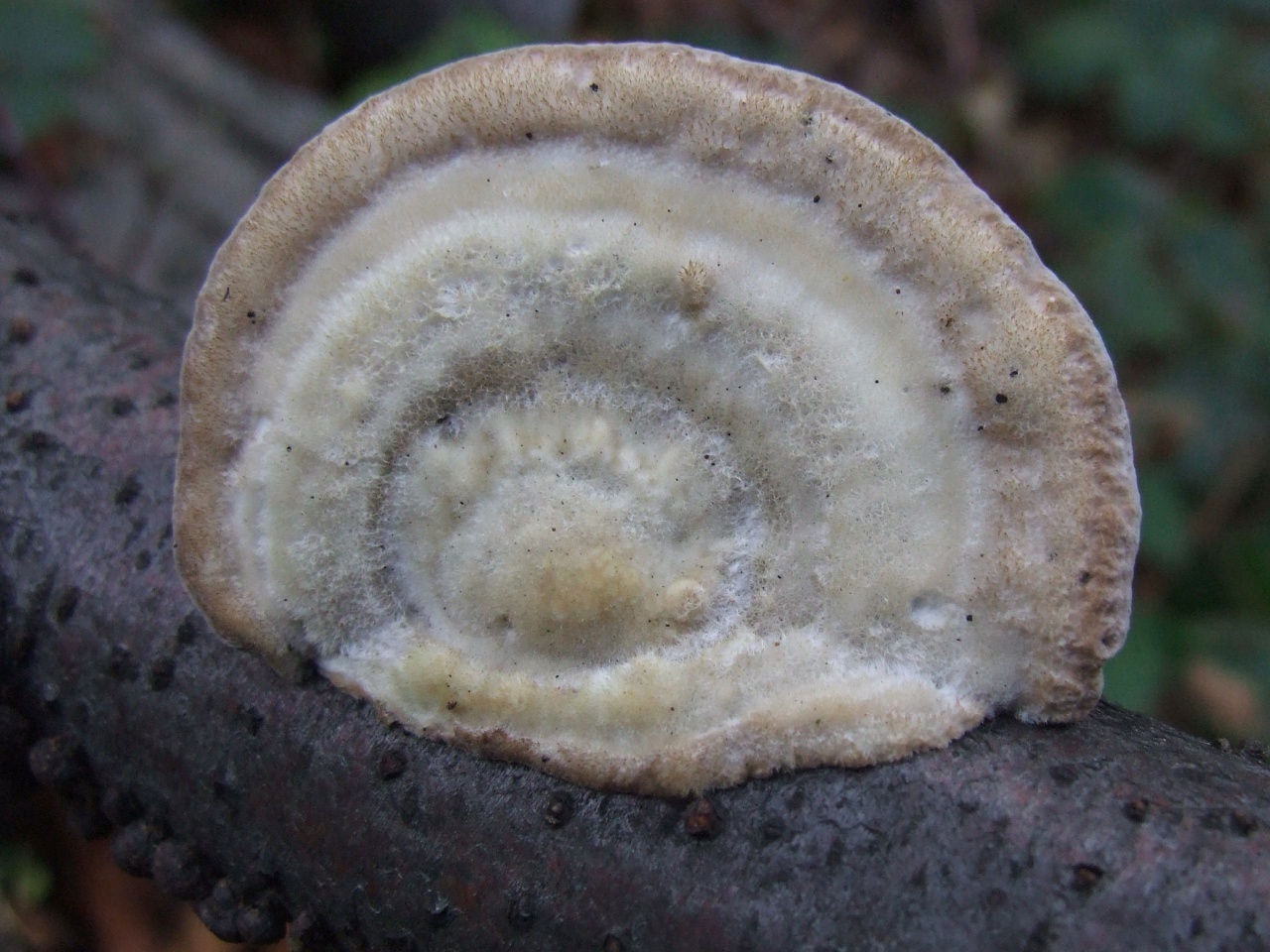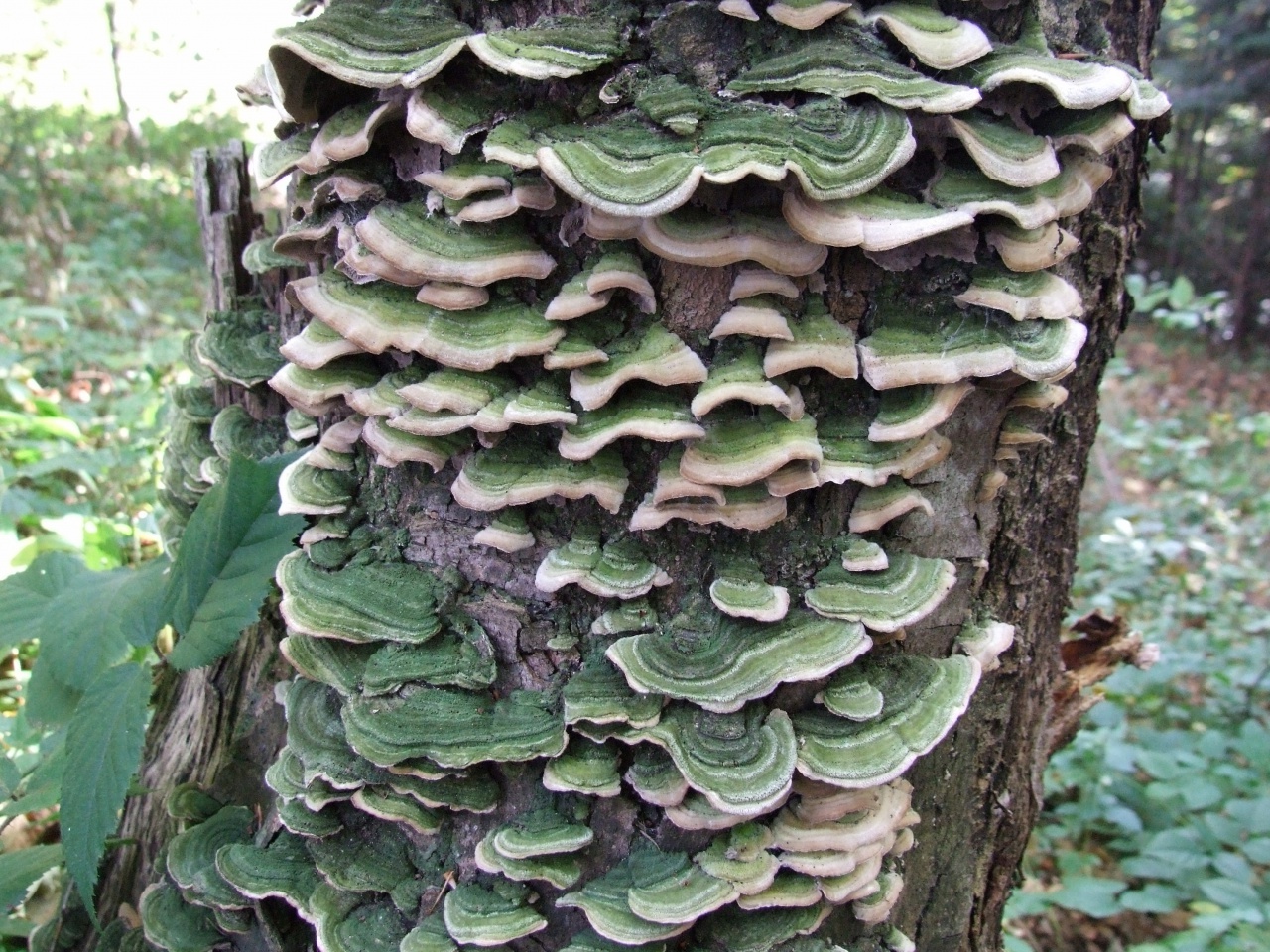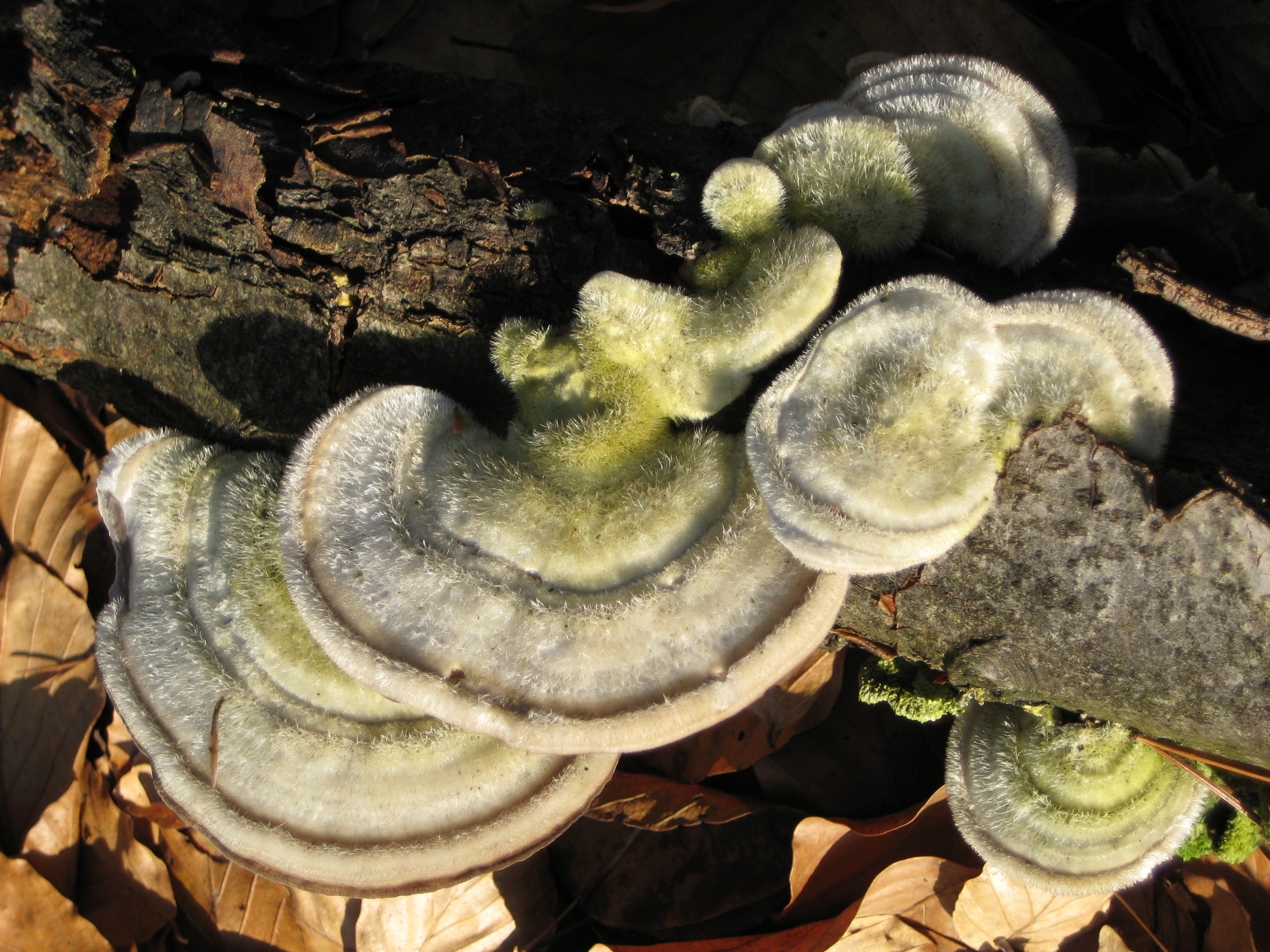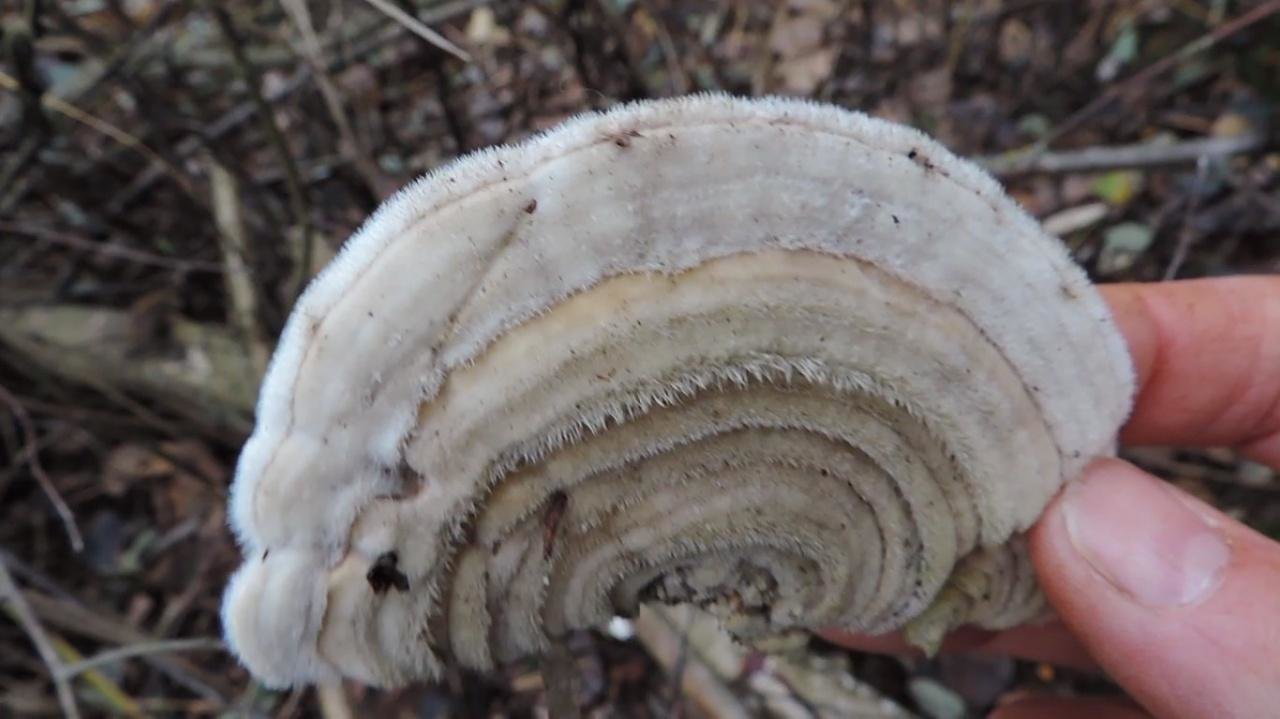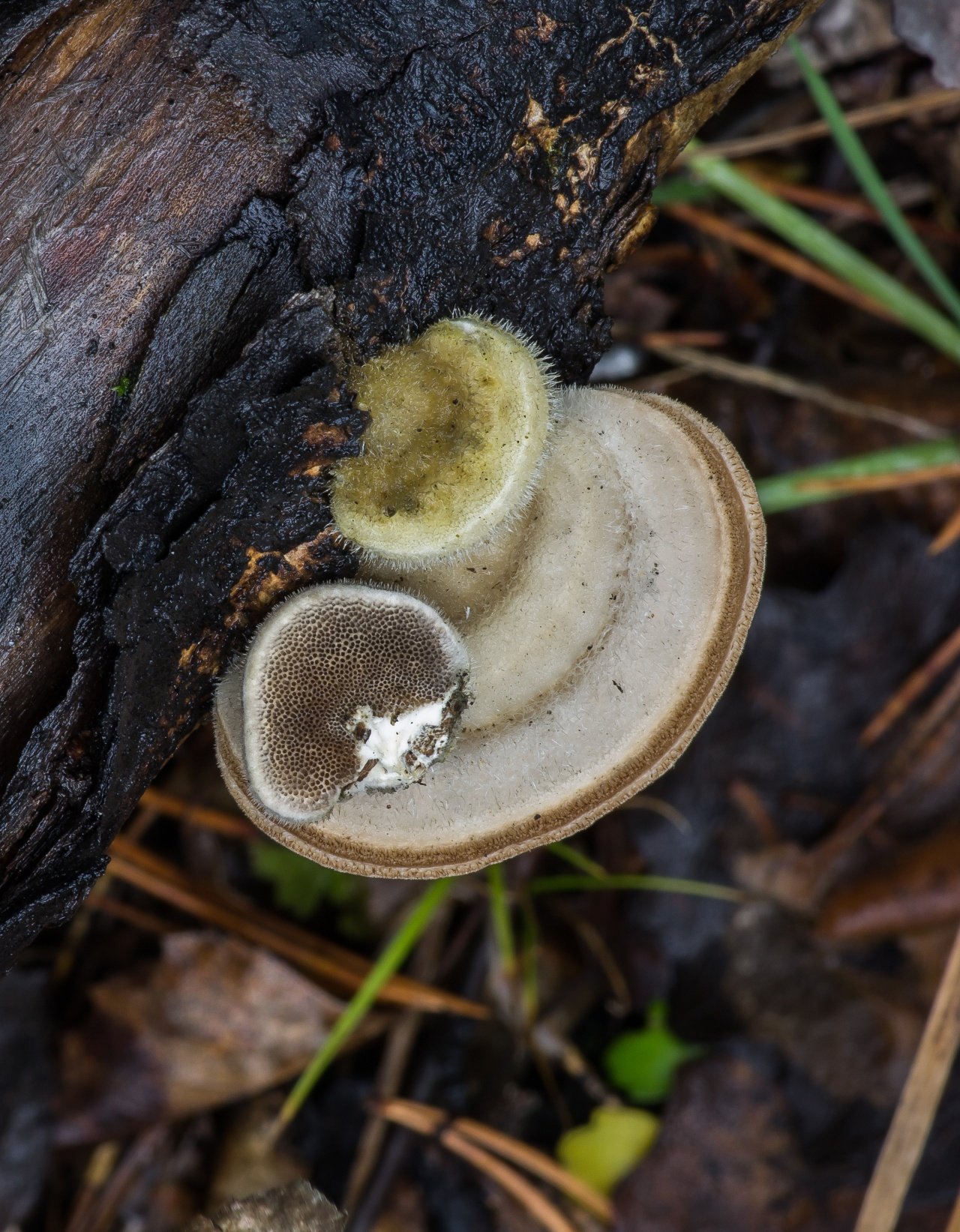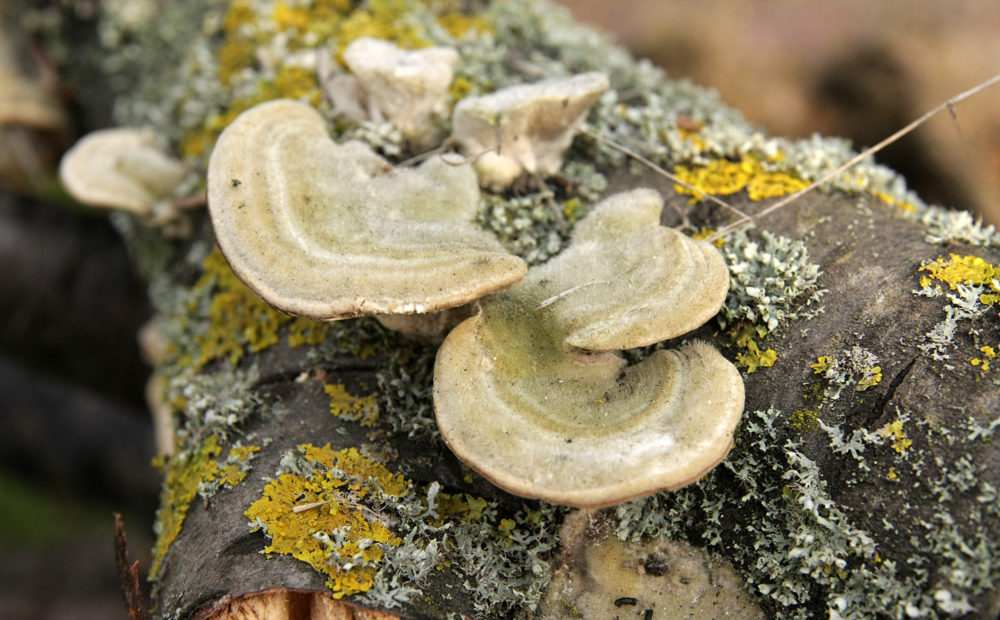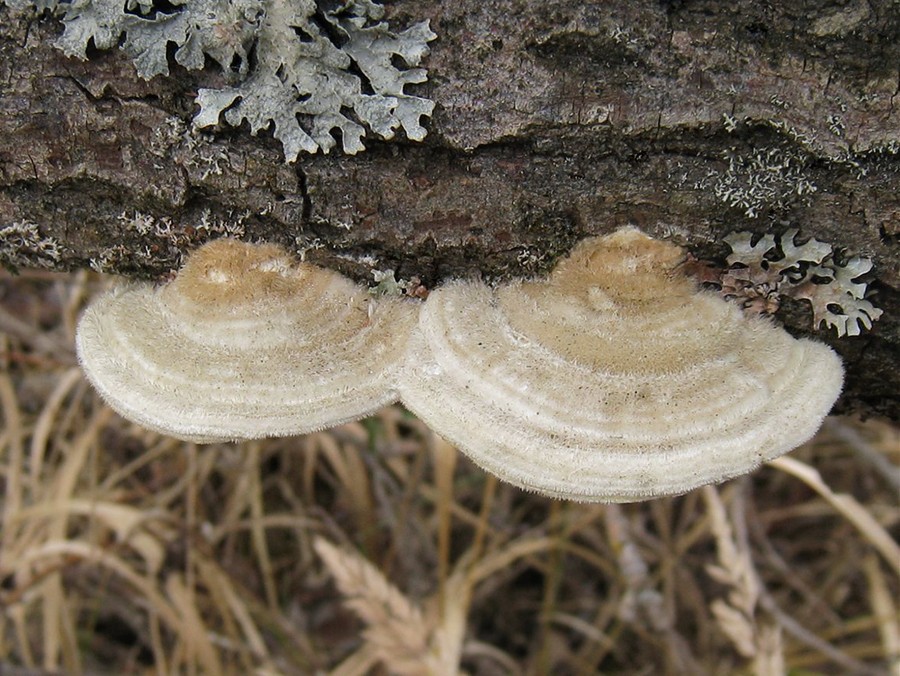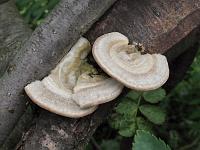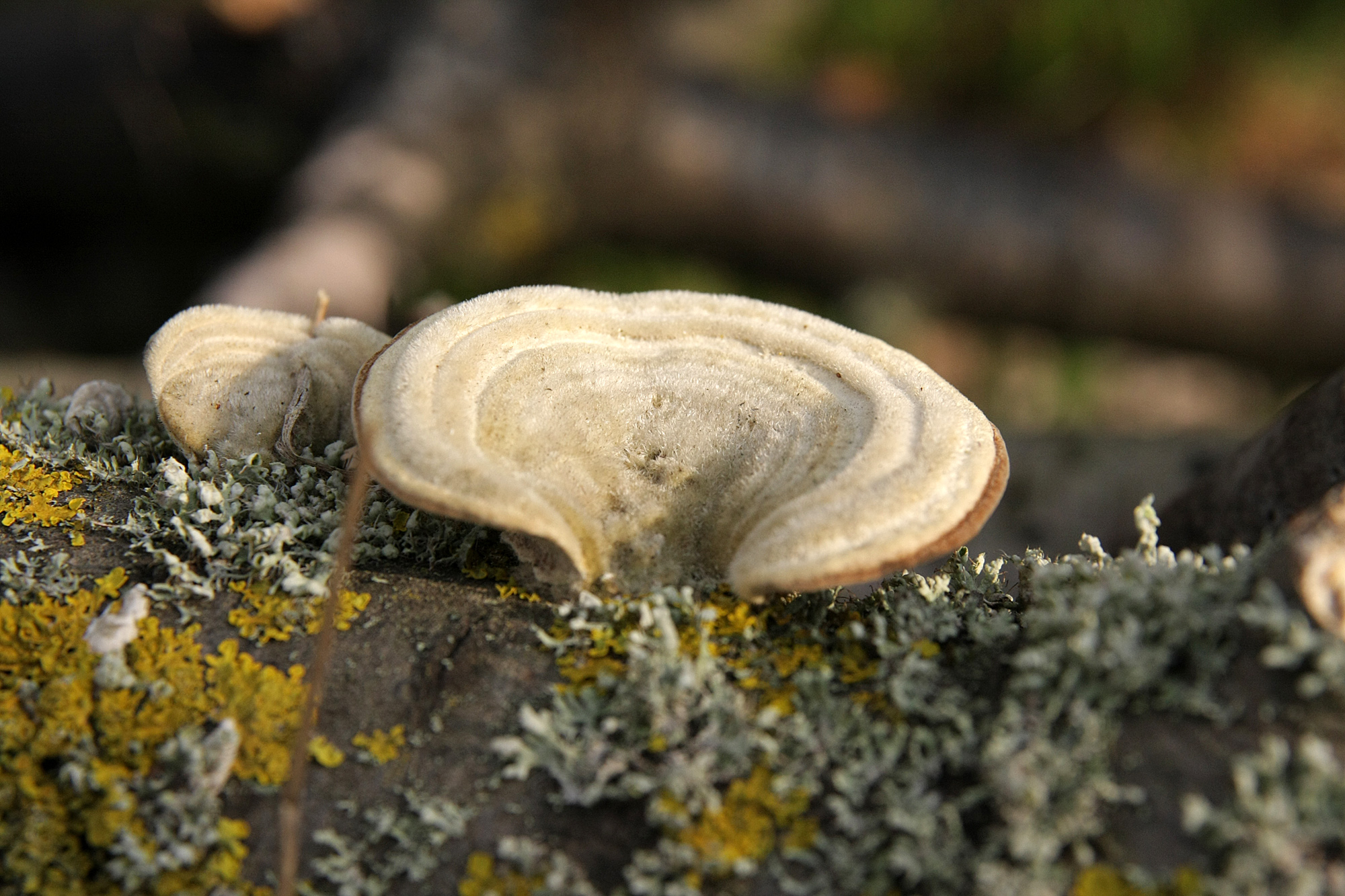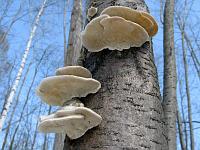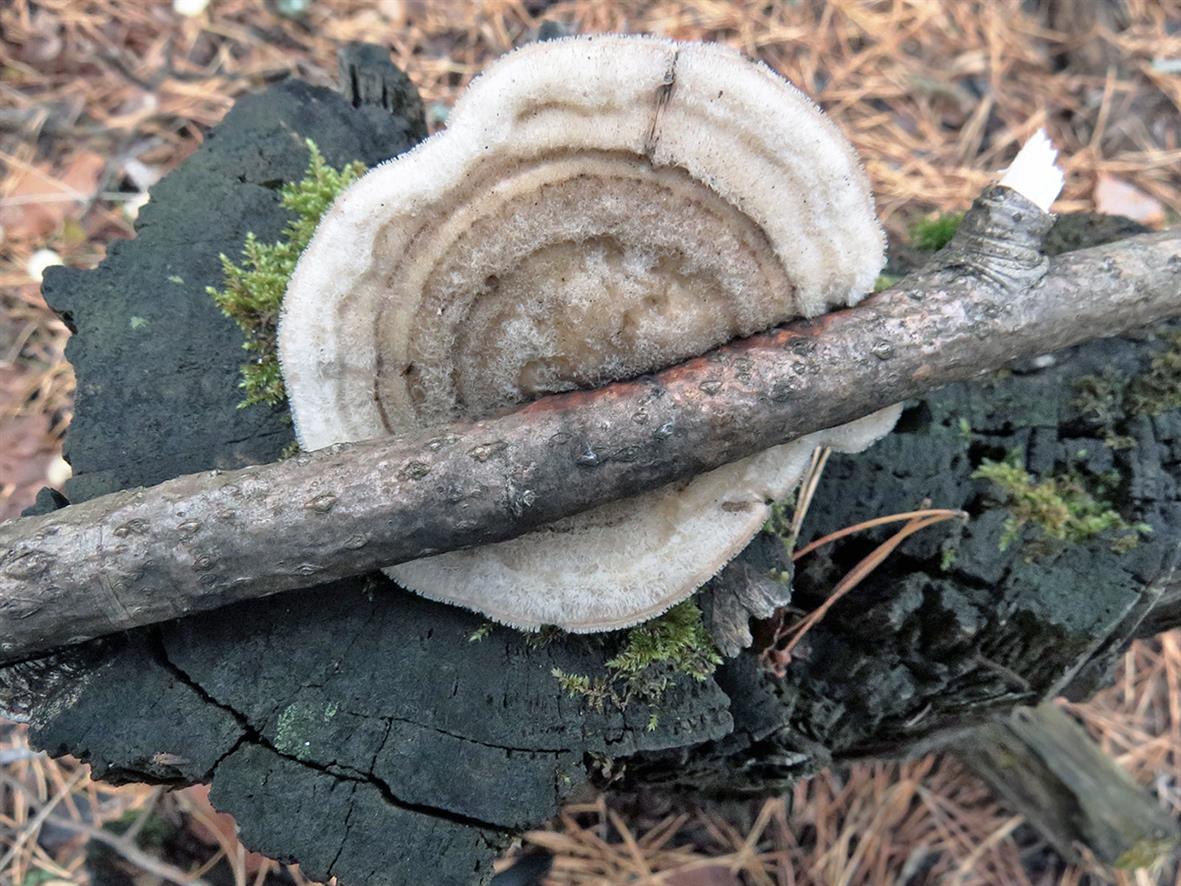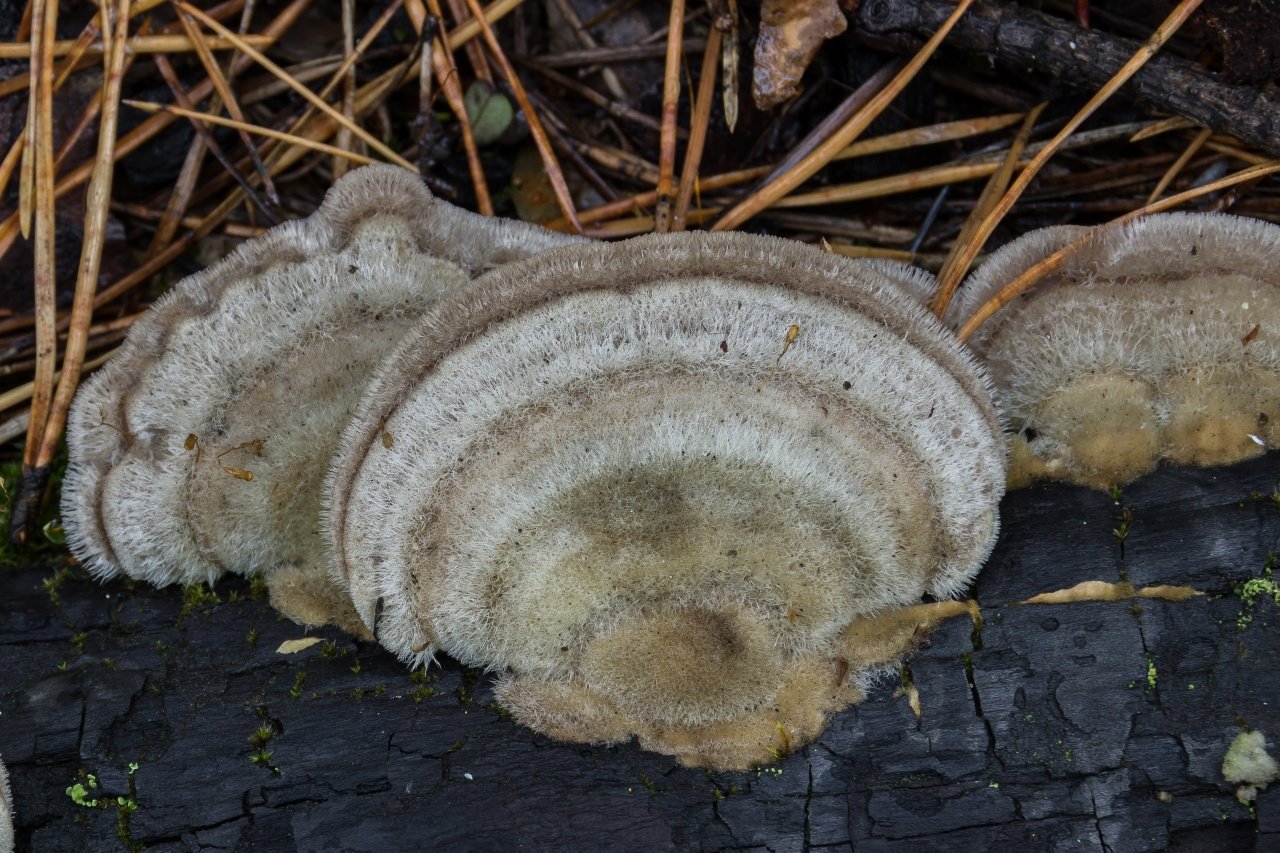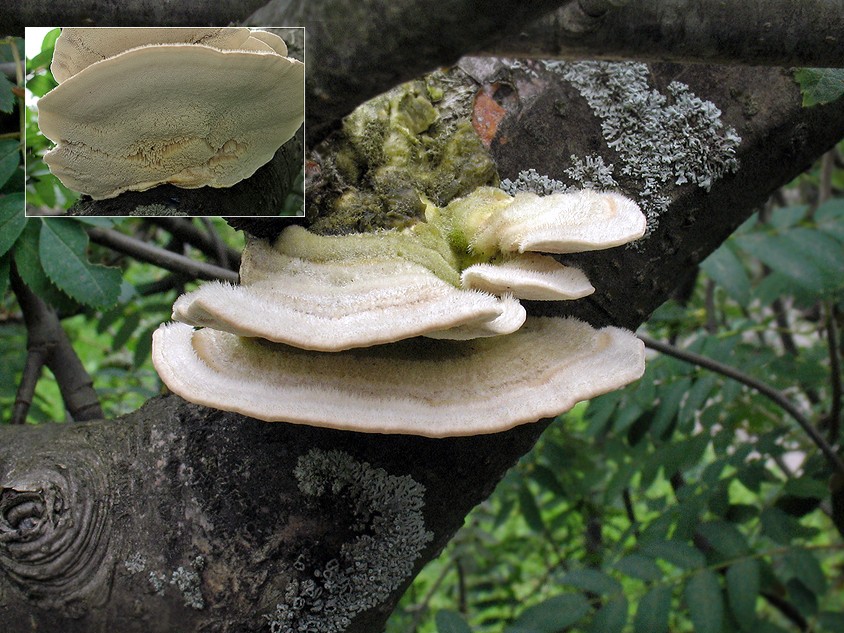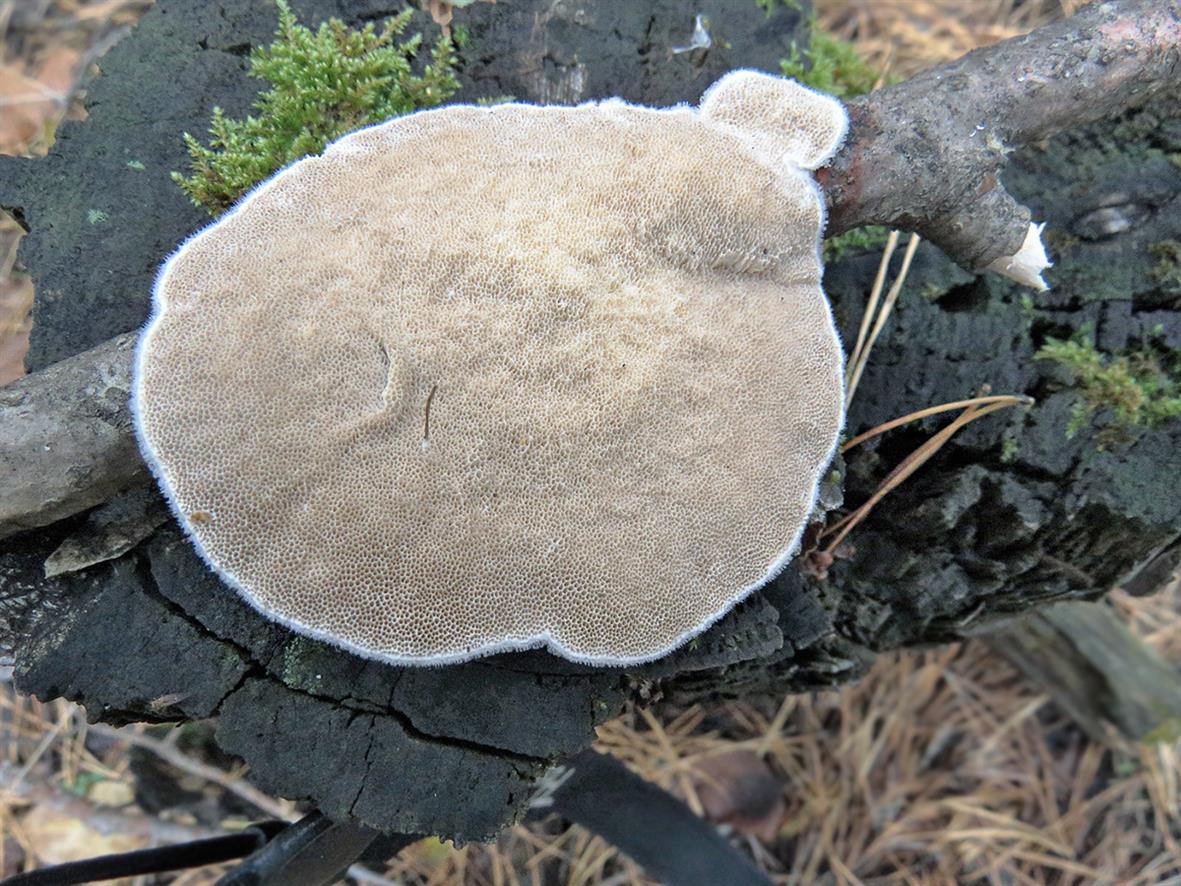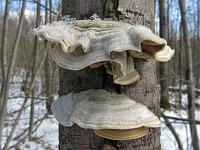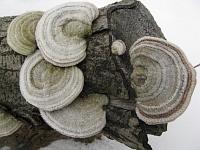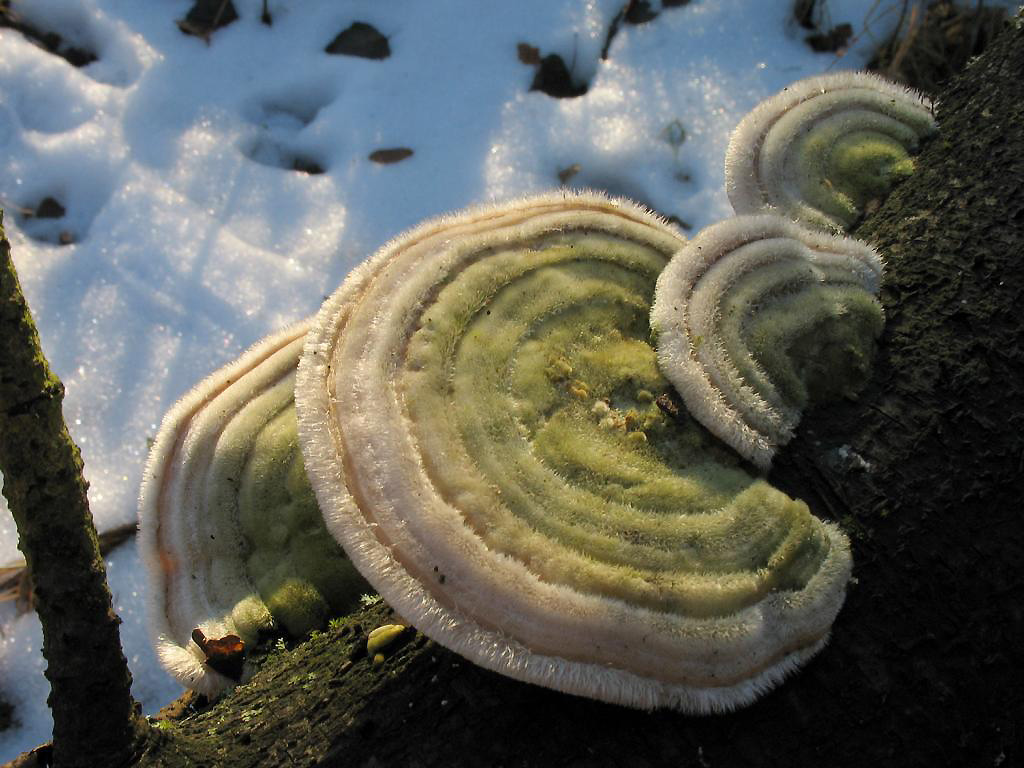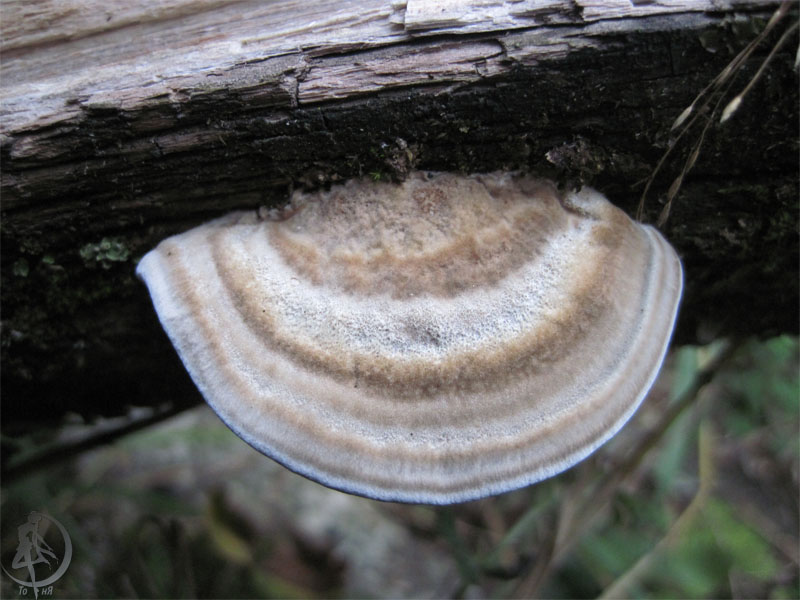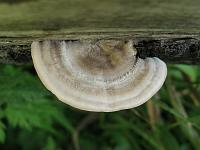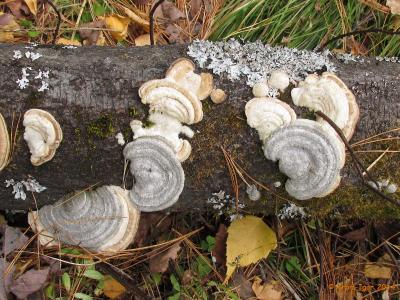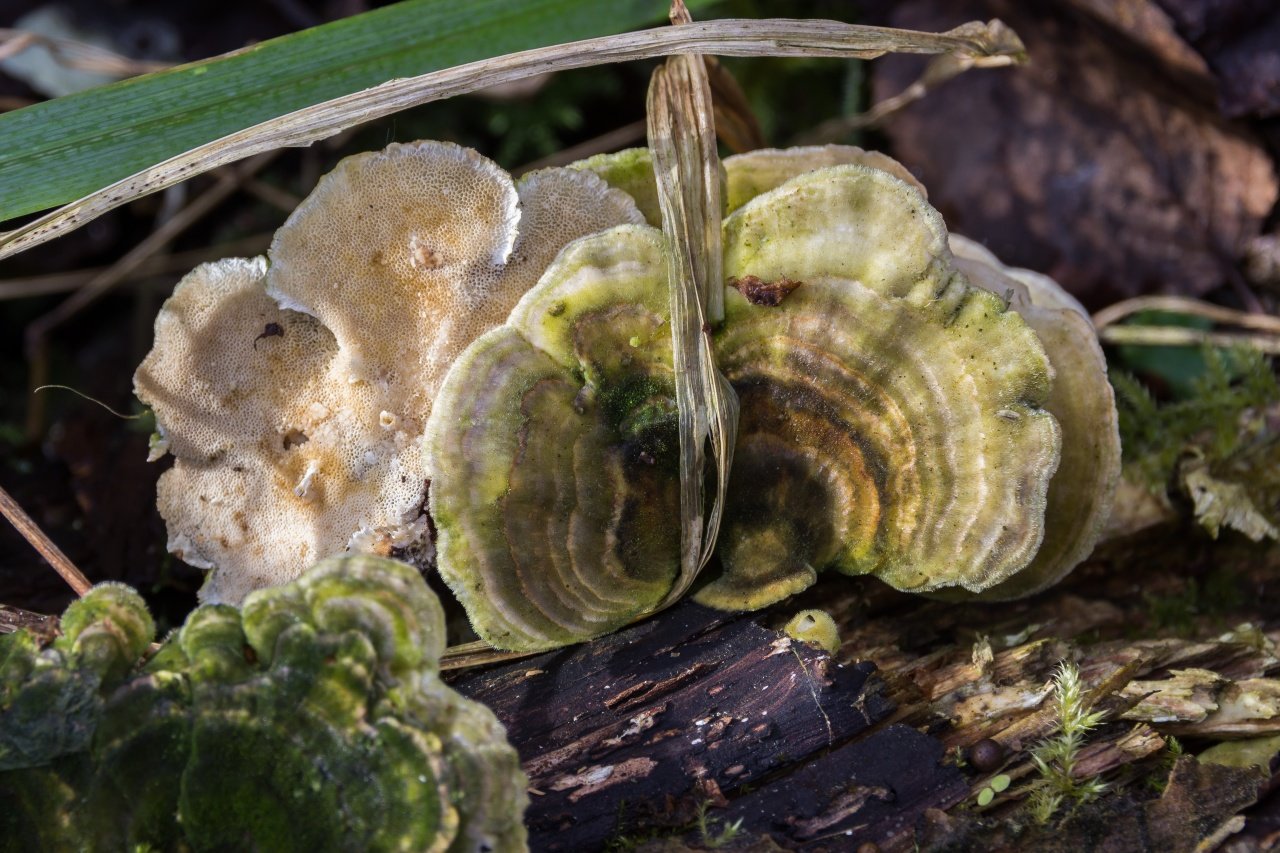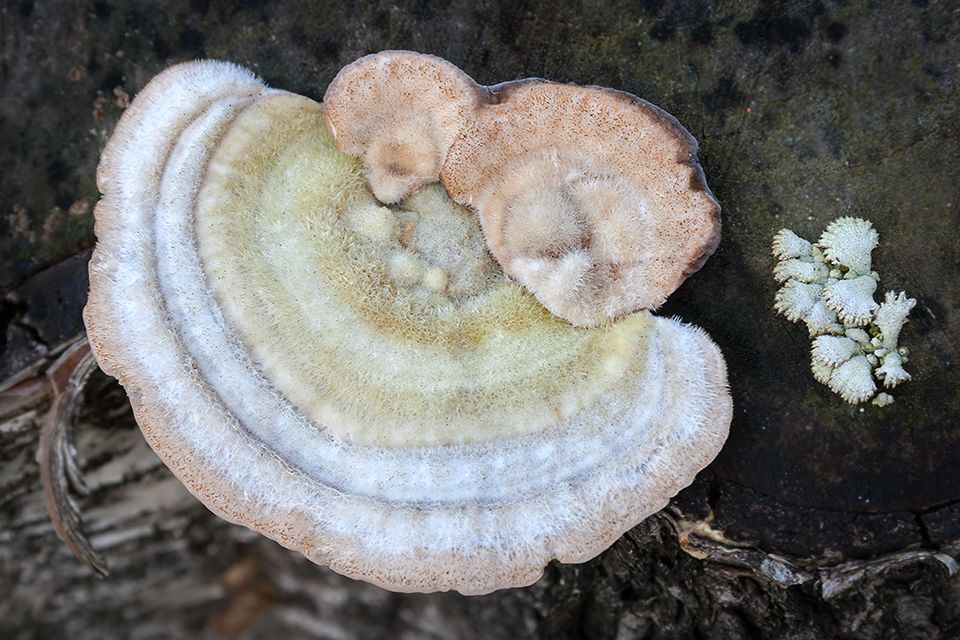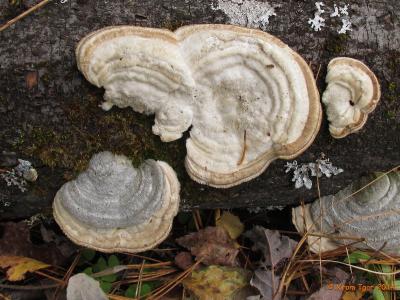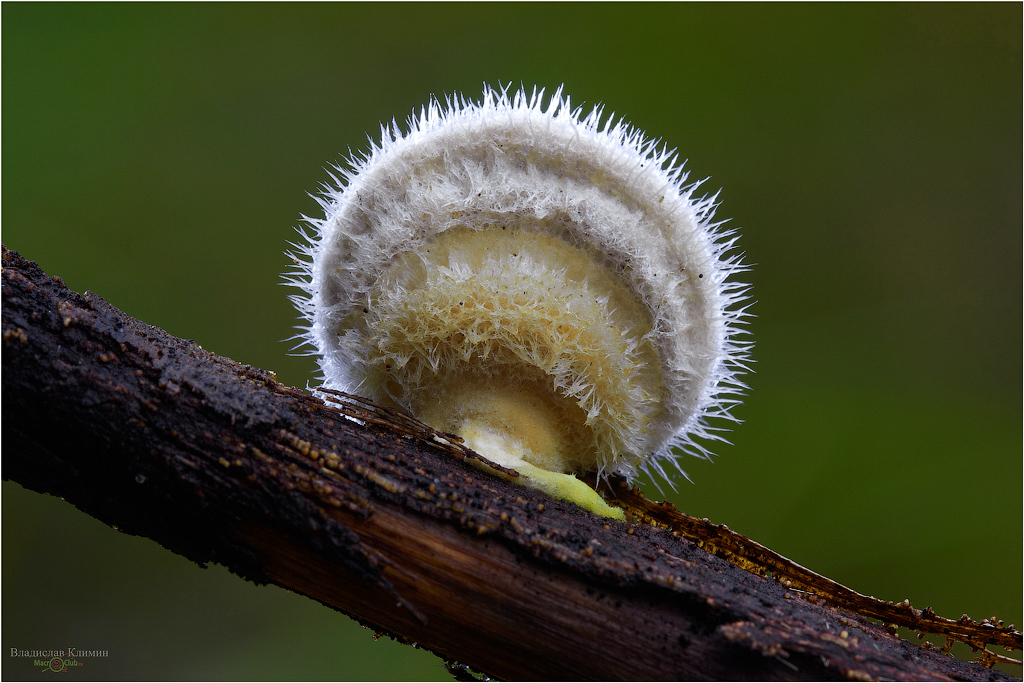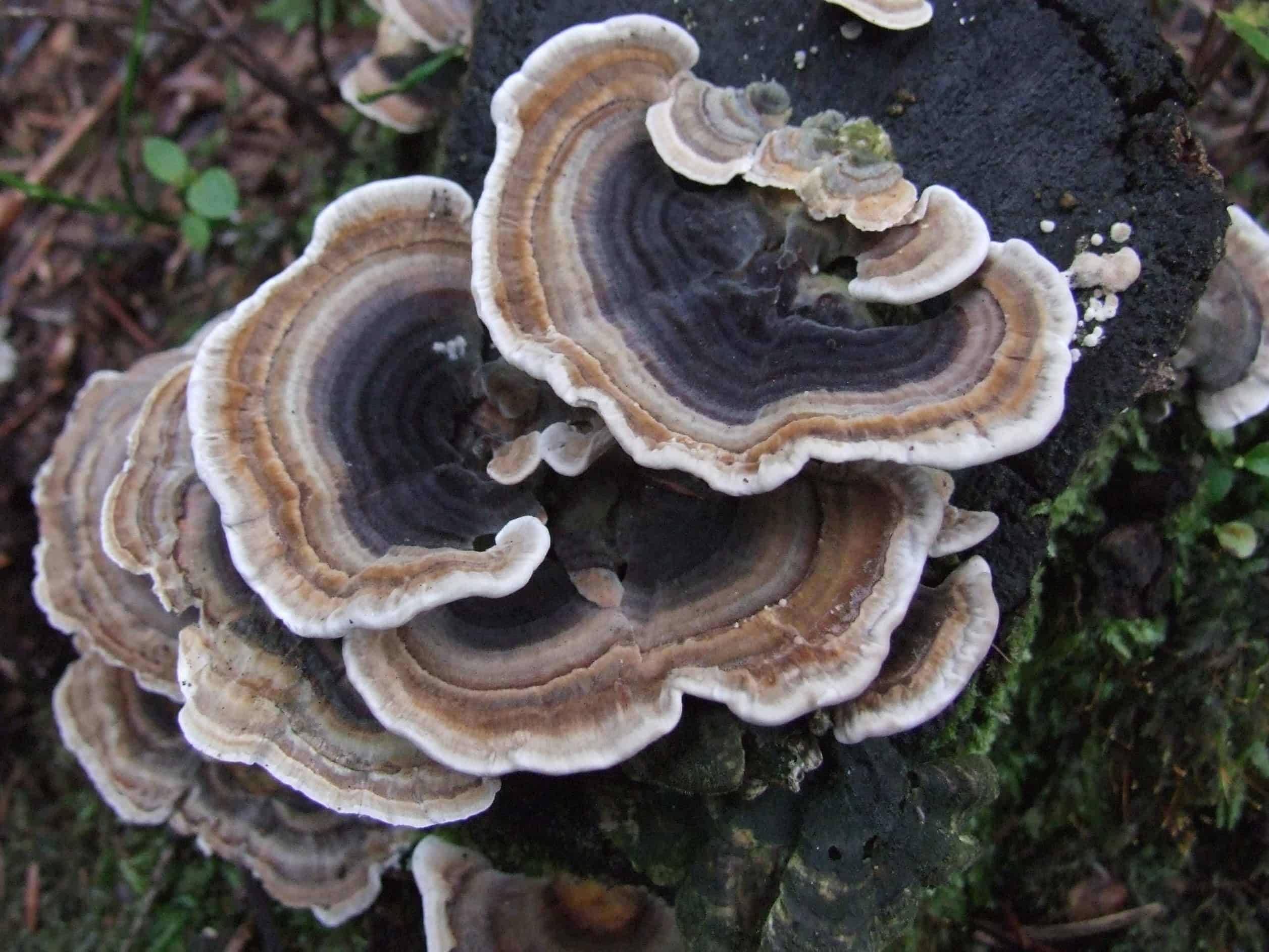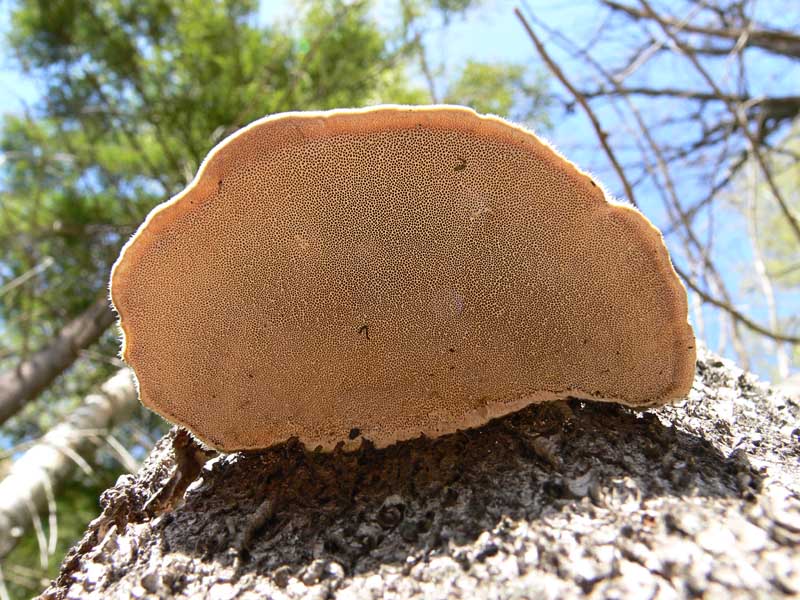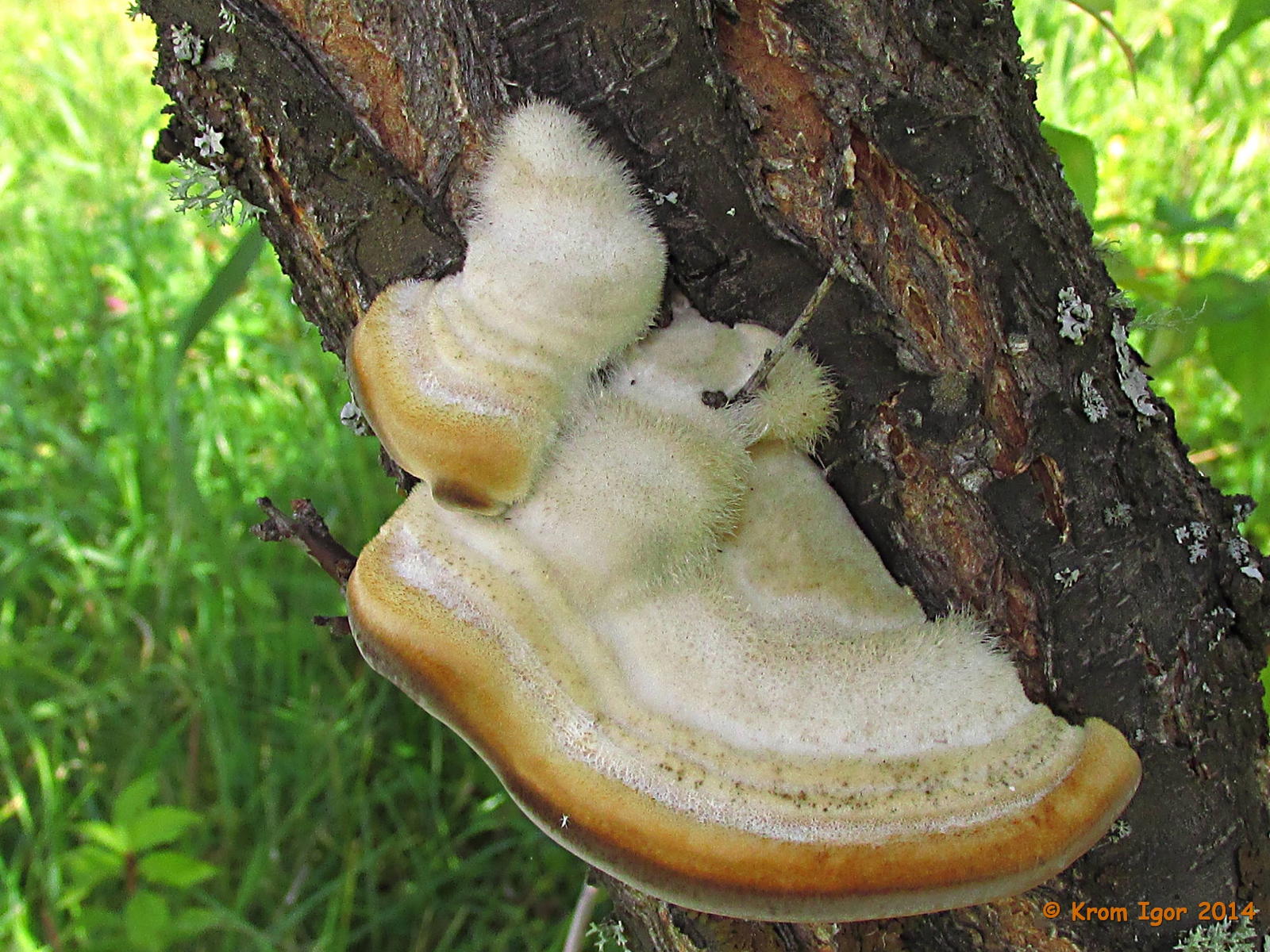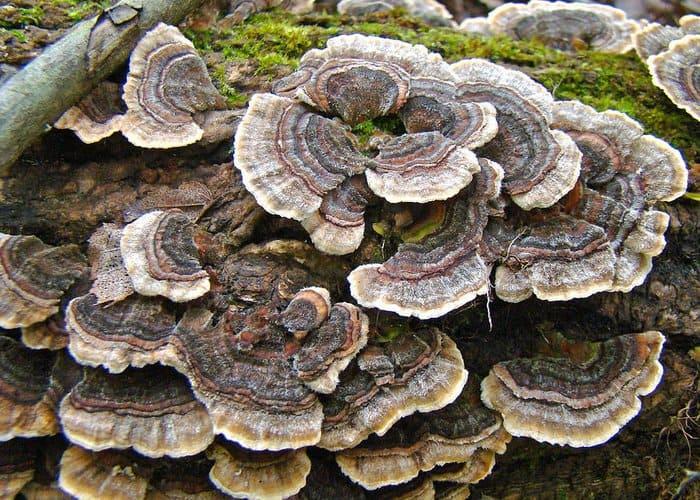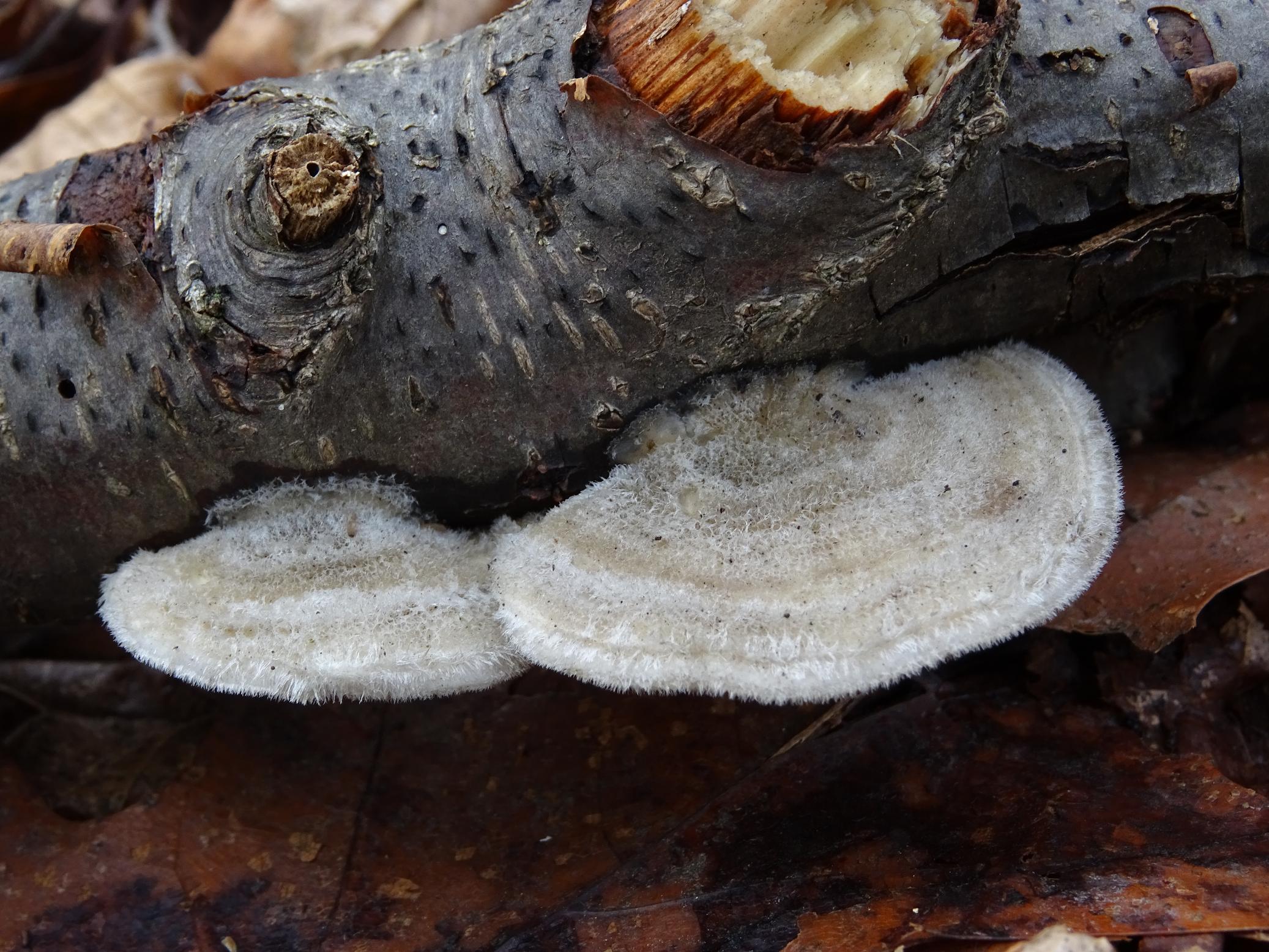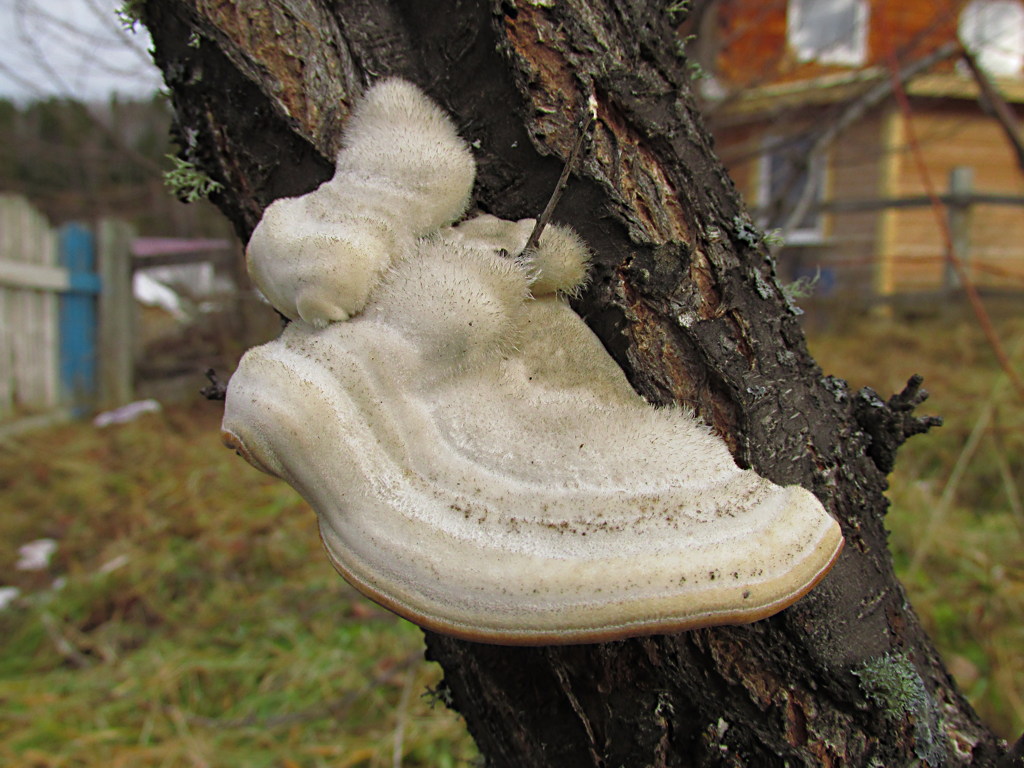Lenzites birch (Lenzites betulina)
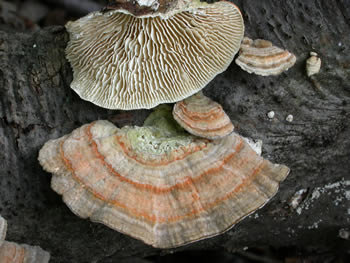 Birch Lenzites has many synonyms:
Birch Lenzites has many synonyms:
- Lencites birch;
- Birch trametess;
- Cellularia cinnamomea;
- Cellularia junghuhnii;
- Daedalea cinnamomea;
- Daedalea variegata;
- Gloeophyllum hirsutum;
- Lenzites flaccidus;
- Lenzites pinastri;
- Merulius betulinus;
- Sesia hirsuta;
- Trametes betulina.
Lenzites birch (Lenzites betulina) is a variety of mushrooms belonging to the Polyporaceae family, genus Lenzites. This type of fungus belongs to the category of parasites that cause white rot in natural wood, as well as destroying foundations in wooden houses that have not been treated with antiparasitic compounds. The spread of birch lensites indicates a serious human impact on the environment.
External description of the mushroom
Mushroom Lenzites birch (Lenzites betulina) has a fruiting body without a stem, annual, thin and characterized by a semi-rosette form. Often, mushrooms of this species are located in whole tiers on a fertile substrate. The edges of the caps are sharp, with parameters 1-5 * 2-10 cm. The upper surface of the cap is a zoned part, the surface of which is covered with a felt, hairy or velvety edge. Initially, it is white, but gradually the pubescence darkens, becomes creamy or grayish. Often, as it darkens, the edge is covered with algae of various colors.
The pores that make up the hymenophore of the fungus are located radially and have a lamellar shape. The pores intertwine with each other, strongly branch, initially have a whitish color, gradually acquire a yellow-ocher or light cream shade. Fungal spores are not colored, characterized by the thinnest walls with dimensions of 5-6 * 2-3 microns and a cylindrical shape.
Trametes hard-haired (Tinder fungus, Trametes hirsuta) how it looks, where and how
Tinder fungus harsh (harsh haired trametes): photo and description
Stiff-haired trametes (Trametes hirsuta) is a wooden mushroom of the Polyporov family, belongs to the Tinder family. Other names:
- Boletus is rough;
- Polyporus is rough;
- The sponge is harsh;
- Tinder fungus harsh-haired.
Although the mushroom is considered an annual, during warm winters it can survive until the next season.

Harsh trametess in an autumn deciduous forest
How harsh haired trametes looks like
The harsh-haired trameteus in most cases grows to the substrate with its lateral part. Sometimes, on horizontal surfaces, the cap has an outstretched shape. Only the fruiting bodies that have arisen are shell-like, with jagged edges. As it grows, the cap straightens out, completely in contact with the flat surface on the side with the substrate, the edges become perfect, slightly wavy. Its diameter can be from 3 to 15 cm, its thickness varies from 0.3 to 2 cm.
The surface is flat, with distinct concentric stripes of different widths. Dense, covered with hard, long fibers. The color is not the same, stripes, different colors of light gray. The pubescence can be snow-white, gray, yellowish-cream, greenish. The edge of the cap is light brown, pubescent. The leg is missing.
Part of the bottom is spongy, the pores are very large, with flexible dense septa, which become thinner and more fragile with age. The color is beige-reddish, white-gray, colors of baked milk or milk chocolate. The surface is uneven, covered with hard white-silvery fibers.
The pulp is thin, consists of 2 distinct layers: grayish, fibrous-soft upper and light woody lower.
Young growth of Tinder fungus harsh looks like a scattering of unusually cut petals
Where and how it grows
Widely popular in deciduous and mixed forests, parks and gardens of temperate climate zones in Russia, Europe, North America. Prefers dead deciduous wood, sometimes settles on conifers. Lives on dead wood, old stumps, fallen trunks. It also grows on still living, weakened, dying trees, preferring the following species:
- bird cherry and mountain ash;
- pear, apple tree;
- poplar, aspen;
- oak and beech.
The period of active growth of mycelium comes in May and lasts until September-October. The harsh-haired trametess is not picky about atmospheric conditions, it loves humid, shaded places. It settles singly and in dense groups, organizing roof-like growths.
Sometimes harsh haired tramesto can be found on rotten fences and a variety of wood buildings.
Eat a mushroom or not
The harsh-haired trametess is classified as an inedible species due to its low nutritional value and tough tasteless pulp. No hazardous substances were found in its composition. It is widely used in the textile, food and cosmetic industries due to the substance it contains - laccase.
These attractive specimens will not work as a snack.
Doubles and their differences
At a very quick glance, the trametez can be confused with some pubescent species of tinder fungus. However, a detailed examination reveals significant differences. no toxic twins were found in this fruiting body.
Fluffy trametes. Inedible, has no poisonous substances. It is distinguished by a yellowish or white color, fleshy, lower spongy part running down the wooden surfaces and angular pores.
The larvae and insects like this fruit body very much, they eat it very quickly.
Cerrene monochromatic. Inedible. It has a pronounced black stripe on the pulp and different-sized, less elongated pores.
The snow-white edge of the edge and the color of the pile make the monochromatic cerrenus special
Lenzites birch. Inedible. Its main difference is the lamellar structure of the geminophore.
In young specimens, the inner side resembles a labyrinth in structure.
Conclusion
The harsh-haired trametess is widely popular throughout the Northern Hemisphere in areas with a temperate northern climate. Benefits forests by converting rotting tree remains into black soil. Its appearance is rather unusual, so it is difficult to confuse it with other types. Inedible, has no toxic substances. You can meet him regardless of the season, the peak of growth is in summer. The harsh-haired trametess can comfortably feel itself on the seams of brown coal, extracting nutrients from it.
TRAMETES FLUFFY
TRAMETES PUBESCENS

System:
Kingdom: Mushrooms (Fungi)
Department: Basidiomycota
Class: Agaric (Agaricomycetes)
Order: Polyporales
Family: Polyporous (Polyporaceae)
Genus: Trametes
Species: Trametes pubescens (Schumach.) Pilát, (1939)
Fruit bodies: annual, sessile, often tiled one above the other, finely fleshy. A surface with unclear zones, soft velvety, felt, whitish, yellowish, without gray shades. The tubules are whitish, then turn brown. With age, the walls of the tubes crack, and they merge. The pores are angular, thick-walled. Fruit bodies are short-lived, quickly destroyed by insects. Habitat: found on dead trunks and branches of deciduous trees (usually on birches), quite often and everywhere. Causes white rot. Fruiting period: July-October. Distribution in the Russian Federation: throughout the forest zone.

Edible: not used for culinary purposes.
Similar species: see T. hirsuta.
Medicinal properties: substances that stimulate the immune system and have antitumor activity have been found. In Japan, in the mid-1970s, the preparation of christening (PSK in the scientific literature) was obtained from pubescent and multi-colored tramets (T. versicolor), which is still used in oncological practice in the complex therapy of cancer patients and as a means of supportive therapy.
On the basis of dry biomass of pubescent tinder fungus, a domestic preparation Tramelan has been created, which is non-toxic and certified as a food additive and is a tableted cultural mycelium with the addition of organic zinc.Tramelan has a positive effect on lipid metabolism, lowers the high content of cholesterol, lipids, improves vascular tone, increases energy metabolism in the cells and tissues of the heart. It causes an increase in vitality, a surge of strength, a decrease in fatigue, is used as an antidepressant.
Cultural mycelium is also used to obtain preparations with an increased content of ergosterol, which has a positive effect on tissue metabolism, stimulates immunogenesis and helps to restore impaired oxidase-mixed liver function.
Medicinal properties of multicolored trameta
Trametes should not be eaten, however, as a medicine, this mushroom has proven itself in the best way. It has a beneficial effect on the nervous system, and most importantly, it can resist oncology.
It is an adversary in the development of various viral infectious diseases.
Contains substances that can be classified as dietary supplements and antibiotics that can affect infection and viruses. Also, it has been scientifically proven that substances from this mushroom can have a positive effect on sleep.
On the basis of tinder fungus, immunomodulatory preparations are most often made, which contain protein polysaccharides. Also, other drugs are made, which also have a polysaccharide nature.
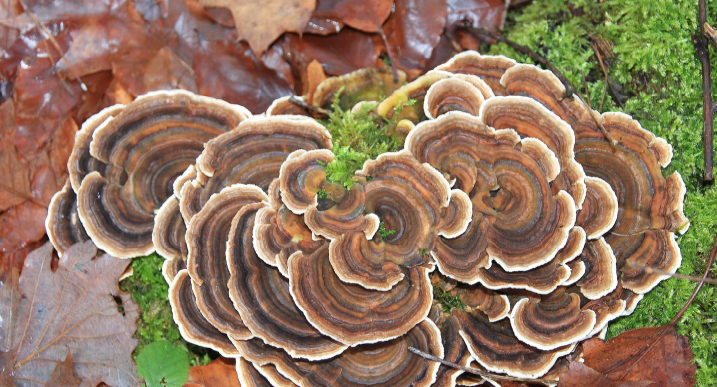
As mentioned above, this mushroom is most often used when it comes to oncology. It is highly effective in the treatment of cancer of the stomach, ovaries, rectum, esophagus.
The preparations containing this mushroom have the ability to regulate the immune system, and can also improve cellular immunity.
Immunity is restored and has a strong effect on people who have been in a state of illness for a long time.
The mushroom is also used in folk medicine, for example, it is most often used in this form to treat the respiratory tract, as well as the digestive tract. He is an opponent of hepatitis B, which has become chronic. Fights tumors that have formed in the liver and stomach.
However, in order to achieve positive results, you need to have an idea of the dosage. For treatment, it is enough from 3 to 5 g of dry mushroom powder per day. However, the dosage should not be drunk right away, but divided into about 3 doses. The ideal time to take the powder is about half an hour before meals.
Use in other countries
Multicolored trametes is a forest dweller, which is widespread not only across the territory of Russia, but also in other states. This means that the experience of using it in the world is much more than we can imagine.
Some peoples call this mushroom "peacock's tail" due to the fact that it has a very variegated color. Indeed, the sheer number of shades that are concentrated on the bonnet are incredible. However, on the territory of Russia, this mushroom is practically not used both for medicinal purposes and for food.
Therefore, in order to understand how tasty and healthy this mushroom is, it is necessary to resort to foreign experience.
The mushroom also grows in Japan. It is there that its healing qualities are well known, so the trameteos is very popular there. On its basis, decoctions and ointments are made, which are simply necessary for the treatment of various diseases. In particular, it helps to fight cancer.
In Japan, mushroom therapy is widespread, which is carried out in a complex manner. The doctor independently selects a diet based mainly on mushrooms. This is done before, also immediately after chemotherapy.
Also, mushroom therapy is mandatory in Japanese medicine in order to help a cancer patient get rid of the disease.
By the way, such methods of experimental medicine are bearing fruit, many people note that a mushroom diet based on Trametes versicolor allows them to feel better, and also, to stop the development of the disease.
However, Japan is far from the only country where multicolored tramete is widely used. This mushroom is considered an excellent general tonic, which allows not only to prevent, but also to effectively treat various malfunctions in the immune system. In addition, preparations made on the basis of this mushroom are an excellent remedy for affecting diseases of the kidneys, liver, blood vessels and joints. Also, the fruit body of tramites effectively acts on hepatitis.
But why does this mushroom work so effectively in the human body?
Scientists believe that the whole point is in a special polysaccharide that is contained in the composition of the mushroom. It's called Coriolanus. It is Coriolanus that allows you to act on an ulcer, inflammation of cancer cells, while affecting the emergence of cellular immunity, which will resist the development of the disease.
Trametes hard-haired
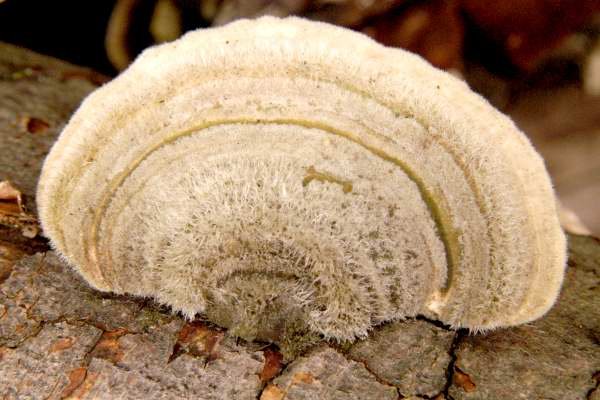
Trametes hirsuta
- Tinder fungus hard-haired;
- The sponge is hard-haired;
- Polyporus hirsutus;
- Boletus hirsutus.
Hard-haired Trametes (Trametes hirsuta) is a mushroom from the Polyporov family, belonging to the Trametes genus. Belongs to the category of basidiomycetes.
External description
Fruiting bodies of hard-haired tramesta have thin caps, the upper part of which is gray. A tubular hymenophore is visible on the bottom of the cap, and there is also a rather hard edge.
Fruiting bodies of the described species are represented by widely accreted half caps, sometimes open ones. The caps of this mushroom are often flat, have a thick skin and great thickness. Their upper part is covered with rigid pubescence; concentric areas are visible on it, often separated by grooves. The edges of the cap are characterized by a yellowish-brown color and the presence of a slight edge.
The hymenophore of the described fungus is tubular, beige-brown, white or grayish in color. There are from 1 to 4 mushroom pores per 1 mm of the hymenophore. They are separated from each other by partitions, which are initially very thick, but gradually become thinner. Fungal spores are cylindrical and colorless.
The flesh of the harsh trametess has two layers, the upper of which is characterized by a grayish color, fibrousness and softness. Below the flesh of this mushroom is whitish, in structure it is cork.
Season and habitat of the mushroom
Hard-haired trametes (Trametes hirsuta) belongs to the saprotrophs, grows mainly on the wood of deciduous trees. In exceptional cases, it can also be found on coniferous wood. This mushroom is widespread in the Northern Hemisphere, in its temperate region.
You can meet this type of mushroom on old stumps, in the middle of deadwood, on dying trunks of deciduous trees (including bird cherry, beech, mountain ash, oak, poplar, pear, apple, aspen). Occurs in shady forests, forest clearings and clearings. Also, tinder fungus can grow on old wooden fences located near the forest edge. In the warm season, this mushroom can be found almost always, and in a mild climate it grows almost all year round.
Similar types and differences from them
There are several similar types of mushrooms in the hard-haired trametus:
- Cerrene monochromatic. Compared to the described species, it has a difference in the form of a fabric with a pronounced line of dark color. Also, in the monochromatic cerrene, the hymenophore contains pores of different sizes and spores, which are less elongated than in the coarse-haired trametess.
- pubescent trametes is characterized by smaller fruiting bodies, in which the cap is covered with small hairs and has a light shade.The hymenophore of this fungus has pores of different sizes, characterized by thin walls.
- Lenzites birch. The main difference between this species and the coarse-haired tinder fungus is the hymenophore, which in young fruiting bodies has a labyrinth-like structure, and in mature mushrooms it becomes lamellar.
Mushroom photo Trametes hard-haired from questions in recognition:
Medicinal properties of fluffy tramesto
In fluffy tramestones, immune substances were found that strengthen the immune system and have an antitumor effect. Since the 1970s, pubescent and multi-colored tramets have been used in Japan to produce creatine, which is used in oncology. This substance is used in complex therapy as a means of supporting cancer patients.
The Russian drug "Tramelan" is made from the dry mass of pubescent tinder fungus. This product is non-toxic and certified as a dietary supplement. Tramelan is a cultured mycelium combined with organic zinc.
This drug has a positive effect on lipid metabolism, lowers cholesterol, improves energy cellular and tissue metabolism and increases vascular tone. Tramelan causes a surge of strength, increases vitality, reduces fatigue. It is also used as an antidepressant.

From the mycelium of pubescent tinder fungus, preparations with a high content of ergosterol are also produced, which improves metabolism in tissues and restores impaired liver function.
Related species of fluffy tramesto
Smoky tinder fungus is an inedible mushroom. The cap of this mushroom is thick and large. Young specimens are friable. The color is yellowish at first, and with aging it becomes brown. The edges are lighter in comparison with the rest of the surface, at first they are sharp, and later become obtuse. During the period of active fruiting, creamy spores appear.
Smoky tinder fungi grow in deadwood and on stumps, giving preference to deciduous species. They also infest fruiting trees such as apple and ash trees.

Birch tinder fungus is also an inedible species of tinder fungus. Its fruiting body is legless, sessile, its shape is reniform, flattened. The color in young specimens is white, later it becomes yellowish. The surface of mature specimens is cracked. Its flesh is tough and bitter.
This is a wood-destroying mushroom, foresters call it a birch sponge. These polypores grow singly or in small groups. They settle on dead and sick birches. The fungus that forms inside the tree causes the development of red rot, which actively destroys the wood.

Similar species
Trametes is not the only one of its kind, it has a lot of doubles, and in general, mushrooms similar to it. Let's find out which forest dwellers can be confused with the tinder fungus, which has a variegated hat and hides in the trees.
Harsh trametess
The harsh-haired trameteos is one of those mushrooms that are very similar to the multi-colored tinder fungus. He also owns a very thin, as well as a semicircular gray hat. However, this hat is not so variegated, saturated in colors. As for the upper part, it is not smooth, it is covered with a kind of large cannons.
It has a canonical form. The pulp itself has two layers at once, in the upper part it is somewhat fibrous, and not very pleasant to the touch. And from the bottom it has a cork structure.
Just like its fellows, the stiff-haired tinder fungus settles on deciduous trees, but it is almost impossible to find them on conifers. Most often found in the northern hemisphere.
Fluffy trametes
Fluffy Trametes is another popular mushroom that also repeats its colorful counterpart. It is worth noting that this mushroom is also not edible, which means that it is not suitable for food. However, unlike its brother, it is annual. His hat is very fluffy if you run your hand over it. Fruit bodies are furrowed, reticulate.The color here most often has an olive tint, less often gray.
The pulp has a white tint, which becomes gray with prolonged interaction with oxygen.
Such mushrooms grow most often on rotting stumps, most of all they like to settle on old trees such as birch and linden. It is very rare to be found on representatives of conifers.
Also, these mushrooms can easily take over processed wood. The fruiting bodies of this fungus are very short-lived, they are quickly destroyed when interacting with woody insects.
Description
Hymenophore
Fruit bodies are annual, in the form of sessile caps, of a hard cork consistency, sometimes completely prostrate. The cap is up to 4 cm wide, its upper surface is coarsely bristly, sometimes with barely expressed concentric zones, creamy beige to ocher beige.
Hymenophore tubular to almost labyrinthine, with thick septa between pores, up to 9 mm thick, dark honey-brownish with age.
The pulp is creamy beige, with a thin (up to 2 mm) underlying strong layer and a thicker (up to 5 mm) fibrous layer; it darkens somewhat upon contact with a KOH solution.
The hyphal system is trimitic, the generative hyphae of the pulp are thin-walled, with buckles, 2–4 µm thick, the skeletal hyphae of the pulp are thick-walled, aseptic, 4–6 µm thick, the connecting pulp hyphae are thick-walled, aseptic, 2–3.5 µm thick. Cystyds are absent. Basidia are tetrasporous, clavate, 18-23 × 6-7.5 µm. Spores are colorless, cylindrical, 7-12 x 2.5-4 microns.
Trametes trogii what it looks like, where and how it grows, edible or not
Trametes Trog: photo and description
Trametes Trogii is a parasitic spongy fungus. Belongs to the Polyporov family and the large Trametes family. Its other names:
- Cerrena Trog;
- Coriolopsis Trog;
- Trametella Trog.
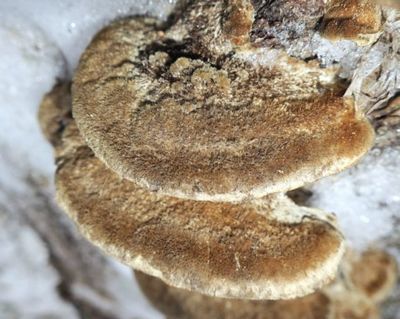
How does Trog's trametez look like?
The annual bodies of the trametes of Trog have the appearance of a regular or undulating rather fleshy semicircle, which is seriously adhered to the substrate by a flat lateral part. In the mushrooms that have just appeared, the edge of the cap is clearly rounded, after which it becomes thinner, becoming sharp. The length can be different - from 1.5 to 8-16 cm.The width from the trunk to the edge of the cap is 0.8-10 cm, and the thickness varies from 0.7 to 3.7 cm.
The surface is dry, covered with thick, long cilia-bristles of gold color. The edge of young specimens is velvety, with a pile, while overgrown specimens are smooth and hard. Implicit concentric stripes, slightly embossed, diverge from the place of growth. The color is grayish-white, yellowish-olive and brown, brown-golden and slightly orange or rusty red. With age, the cap darkens, becoming a honey-tea color.
The surface is tubular inside, with distinct large pores from 0.3 to 1 mm in diameter, complex shape. First of all, they are rounded, after which they become angularly serrated. The surface is uneven, rough. Color from bright white to cream and gray-yellowish. As it grows, it darkens, becoming a coffee color or a faded lilac hue. The thickness of the spongy layer is from 0.2 to 1.2 cm. White spore powder.
The flesh is whitish, changing its own color as it matures to a creamy gray and pale reddish olive. Rigid, fibrous cork. The dried mushroom becomes woody. The aroma is sour or pronounced mushroom, the taste is neutral-sweet.
Trametes Trog can be evenly spread with folded edges or an inverted spore-bearing sponge outward.
Where and how it grows
Trametes Troga prefers to settle on deciduous species - both soft and hard: birch, ash, mulberry, willow, poplar, walnut, beech, aspen. Not often you can see it on the pines. The mycelium in this species is long-term, fruiting bodies appear in the same places every year.
The mycelium begins to actively bear fruit from mid-late summer to stable snow.They grow singly and in large colonies, located in the form of tiles and side by side, very often you can meet ribbons grown together with the sidewalls of these fruit chalk.
Prefers sunny, dry, wind-protected places. It is distributed everywhere in the northern and temperate latitudes - in deciduous forests and taiga zones of Russia, in Canada and the United States. Sometimes it can be found in European countries, as well as in Africa and South America.
This species spoils the host trees, causing rapidly spreading white rot.
Eat a mushroom or not
Trametes Trog is an inedible species. No poisonous and toxic substances were found in its composition. The tough woody pulp makes this fruiting body unattractive to mushroom pickers. Its nutritional value is very low.
Doubles and their differences
Trametes Trog is similar to fruit bodies of its own kind and other tinder fungi.
Trametes is harsh-haired. Inedible, non-toxic. Can be recognized by very small pores (0.3x0.4 mm).
Long bristly villi are white or creamy
Fragrant trametes. Inedible, not poisonous. It is distinguished by the absence of pubescence on the cap, light, gray-white or silver color and a strong smell of anise.
Prefers loose poplar, willow or aspen
Gallic Coriolopsis. Inedible mushroom. The cap is pubescent, the spongy surface is dark-colored inside, the flesh is brown or brown.
It is easy to distinguish from Trog's trametess due to its darker color.
Antrodia. Inedible look. Their main difference is large-celled pores, sparse setae, white flesh.
This large genus includes varieties recognized as medicinal in the alternative medicine of the East.
Conclusion
Trametes Trog grows on old stumps, large deadwoods, besides damaged living trunks of deciduous trees. The fruiting body develops during the fall season and is able to survive the winter. It lives in one place for several years - until the complete destruction of the carrier tree. Can be found in the Northern and Southern Hemispheres. Widely popular in our country. In European countries, it is included in the lists of rare and endangered species. The mushroom is inedible because of the tough, unattractive pulp. No poisonous species were found among the twins.


